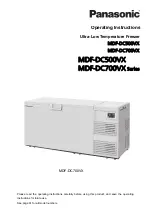
4
!! IMPORTANT !!
Failure to closely follow operational and
maintenance procedures may result in damage to
the unit and / or void your warranty. Coldelite
Corporation will not be responsible for any machine
not properly operated or maintained.
Part I – Installation
Before starting this procedure, ensure that the
shipping carton does not show any evidence of
damage due to dropping or mishandling. This may
indicate that the freezer was damaged during transit
or delivery.
!! IMPORTANT !!
Should the outside of the shipping carton give any
indication of possible damage, state this on the bill
of lading prior to signing. Contact the freight
carrier and request an inspection of damage. If this
procedure is not adhered to, you will forfeit your
rights to file a damage claim and be responsible for
subsequent repair costs.
A)Uncrating the Freezer
1) The outer shipping carton is secured to the
shipping pallet with strapping. When cutting this
strapping, do so with caution as it may spring out
quickly. After cutting the strapping, lift the shipping
carton straight up and off of the freezer.
2) Remove the protective foam boards and plastic
wrapping from the outside of the freezer.
3) The freezer is also secured to the shipping pallet
with strapping. Again, exercise caution when
cutting this strapping since it may spring out
quickly.
4) You must now remove the side panels from the
freezer prior to lifting the freezer off of the pallet
with a lift truck. To remove the side panels, first
remove the side drip chutes and lower chute cover
on both side panels. Next remove the screws in each
side panel and gently pull down and away from the
machine frame. Remove the protective plastic
coating from the outer panel surfaces.
B) Positioning the Machine
After removing the machine from the shipping
pallet, it is now ready to be located in its final
location.
Prior to choosing a location keep in mind that the
freezer should be accessible for periodic
maintenance and have adequate space for necessary
airflow.
Figure 1
1) The freezer is equipped with pivoting casters to
allow for ease of movement. When placed in its
final location, lock the caster brakes to prevent
unwanted movement of the freezer. (Refer to Figure 1)
2) The freezer must also be level to ensure proper
drainage from the mix tanks and cylinders. To
level, place a level on all corners and shim the
casters as needed.
Figure 2
3) If your freezer is air cooled, you
MUST
have
adequate spacing on both sides and rear of the
machine. You should have a minimum of 4 inches
of clearance on both sides and 12 inches of
clearance on the rear of the machine. This will
ensure an adequate airflow is maintained.
(Ref. to Figure 2)
Note
: If these clearances are not maintained, the
production capacity will be reduced, cycling will be
increased and the potential will exist that the machine
will stop completely
4"
12"





































